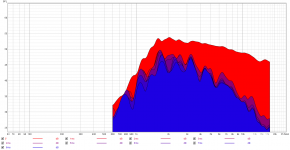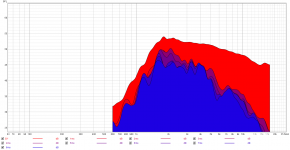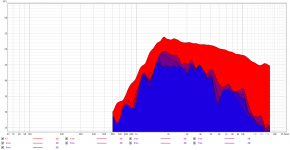It's quite possible as that is the frequency range where this sort of shape causes the greatest difference.It sounded good pulled out away from the rear wall, but it also sounded good up against the rear wall. I particularly remember the quality of the upper bass... Maybe I was hearing the effect of the radiation pattern?
Fluid - I am highly interested in this topic, so please don't be discouraged. Can you show an example where box shape (beyond the baffle shape) has a significant impact?
I'm not discouraged I just try and stay away from things that seem to be turning argumentative. If someone else sees something different in the data and patterns I have zero interest in trying to change their mind. Having to justify everything you write becomes tiresome (ASR effect) and I'm getting to the point where I can't remember exactly where everything came from so easily anymore.
It is the whole combination that creates the overall effect, the distances involved from baffle size, the ratios from width to depth, how much chamfering or rounding has been used and what type, the directivity of the driver itself. They all combine to create the outcome and some combinations work well together if you are targeting a certain type of response. I don't really see the point in being reductive and it is very hard to know beforehand what will make an audible difference particularly one for the better. Sometimes small changes have big audible impacts other times things that look a total mess sound just fine.
Here is an example but as I said above it's not so easy to decide just what it was that caused what in the response.
https://www.audiosciencereview.com/...e-platform-speaker-project.20407/post-1082442
There is no need to apologize to me, your tone does not seem bitter. Mostly your posts seem enthusiastic and I don't want to dampen that. I do wish sometimes you would take more time in the first place to make your thoughts more succinct and not need so many edits as I struggle to wade through all the words and images to see your point. Your mind might be open for change (which is a good thing) but the bar is set quite high, higher than I am willing to jump. I've posted most of what I think and have found out about this subject somewhere when it seemed relevant, enough that I don't even remember where it all is now.So, I sincerely apologize you and others if I come across with bitter tone. After all we are here to learn, at least thats the original motive for me and I'm sure many of readers as well. I hope you and others would share your findings and amusings on this and other subjects, for us all to learn. I'm very much into changing my mind when new information comes into light so mind is only made up for now with the information I've gathered so far. Please, feel free to pointer me to resources if you know it exists as I'm not afraid to be wrong and corrected. Kudos
Thanks for feedback, my posts are mostly ad-hoc and I get from your response too much for you long timers. I should prepare and condense them down to get more interaction with you and others.
With risk of being silly and continuing I've also posted tens of results and looked and hundreds and they all show the same, baffle pretty much defines the pattern. All data all seems to indicate baffle size including what you have showed so far. For example the BEM sim referred in ASR by you is just the baffle with some extra ripple added by the back.
You are absolutely correct it is cardioidish response to low frequency but it seems to be so because its a big object. All I see from the data no matter which way I look pattern is pretty much defined by the size of the baffle.
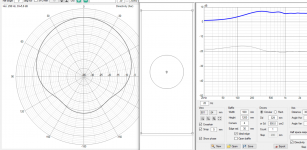
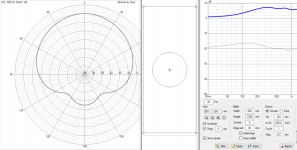
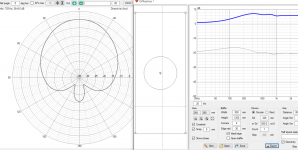
You've already seen this but for others reading Mabat showed BEM sims with varying box depth in ATH thread and its the same story. Depth, or back of the box, has effect on pattern absolutely correct, but its only ~1db if you eyeball any of the lines they don't deviate any more than about 1-2db. https://www.diyaudio.com/community/...-design-the-easy-way-ath4.338806/post-6972605
Now, delays that are related to depth could make audible difference but I see it very hard to hear / evaluate as the effect seems quite small, ~1db ripple in frequency response indicates the secondary sound is roughly +20db down. This would make an interesting discussion if there was some particular delay that is not so audible than others perhaps. Making box as shallow as possible keeps delays low and sound should integrate to direct sound. Also something what all data indicates to me, keeping structure minimal has least side effects to direct sound, only shy to sphere. This is very good thing, small things are easier and cheaper to fabricate.
edit. as habbit 😀 Just checked there seems to be 3176 screenshot files in my mixed loudspeaker simulation demonstration dumpster folder so there has been quite some amount of data to observe. Not all is for this context, but a big portion nevertheless.
With risk of being silly and continuing I've also posted tens of results and looked and hundreds and they all show the same, baffle pretty much defines the pattern. All data all seems to indicate baffle size including what you have showed so far. For example the BEM sim referred in ASR by you is just the baffle with some extra ripple added by the back.
You are absolutely correct it is cardioidish response to low frequency but it seems to be so because its a big object. All I see from the data no matter which way I look pattern is pretty much defined by the size of the baffle.



You've already seen this but for others reading Mabat showed BEM sims with varying box depth in ATH thread and its the same story. Depth, or back of the box, has effect on pattern absolutely correct, but its only ~1db if you eyeball any of the lines they don't deviate any more than about 1-2db. https://www.diyaudio.com/community/...-design-the-easy-way-ath4.338806/post-6972605
Now, delays that are related to depth could make audible difference but I see it very hard to hear / evaluate as the effect seems quite small, ~1db ripple in frequency response indicates the secondary sound is roughly +20db down. This would make an interesting discussion if there was some particular delay that is not so audible than others perhaps. Making box as shallow as possible keeps delays low and sound should integrate to direct sound. Also something what all data indicates to me, keeping structure minimal has least side effects to direct sound, only shy to sphere. This is very good thing, small things are easier and cheaper to fabricate.
edit. as habbit 😀 Just checked there seems to be 3176 screenshot files in my mixed loudspeaker simulation demonstration dumpster folder so there has been quite some amount of data to observe. Not all is for this context, but a big portion nevertheless.
Last edited:
What you guys think about the dealy time of box related secondary sounds like diffraction?
Like room reflections they come like tax bill. Would it be better to have them before say 1ms or more? I've tried to find tips from psychoacoustics but haven't been able to come to a conclusion, not enough understanding and insight yet. Intuition says when the delays are not much different than the direct sound its not any worse, I mean if the edges are about max driver radius away then its roughly the same as if they were emitted by the driver. Yeah driver sizes vary but so does bandwidth they emit so edge diffraction is even back of the box can be kept quite low, about diameter wavelength. Perhaps there is some hints on head size, HRTF stuff? Well, of to other things now.
Like room reflections they come like tax bill. Would it be better to have them before say 1ms or more? I've tried to find tips from psychoacoustics but haven't been able to come to a conclusion, not enough understanding and insight yet. Intuition says when the delays are not much different than the direct sound its not any worse, I mean if the edges are about max driver radius away then its roughly the same as if they were emitted by the driver. Yeah driver sizes vary but so does bandwidth they emit so edge diffraction is even back of the box can be kept quite low, about diameter wavelength. Perhaps there is some hints on head size, HRTF stuff? Well, of to other things now.
It is silly to keep going about something the same way and expecting a different result. If you don't see what I do so be it. You say it is red, I say kind of but the colour is crimson. You say crimson is red, I say no it's close but not quite the same. You say, I've looked at hundreds of pictures and they all look red to me so red is all there is to it.With risk of being silly and continuing I've also posted tens of results and looked and hundreds and they all show the same, baffle pretty much defines the pattern. All data all seems to indicate baffle size including what you have showed so far. For example the BEM sim referred in ASR by you is just the baffle with some extra ripple added by the back.
Yeah I would be very happy if you wrote what you see, what is it? I've been asking this many times from AllenB and similar thing happens with you now, I'm not sure how to see the right thing you are seeing so please guide how to look the data like you, thanks.
I keep on reading that I'm told what I see is wrong but nobody shows counter arguments or what is it that is wrong in what I see, I'm kind of lost. I'm looking and asking what is it that should I be looking for but I cannot see and no one is pointing at it so it feels there is nothing else.
Pardon my tone of writing but this is all I'd like, to learn, what is it that I don't see since many are pointing there is something but no matter how I look at it it looks like nothing and I'd like to understand why, or what is it, in order to learn.
edit. I try to represent my view on the subject as well as I can, and would like if you did as well so I could see it. Now this is single sided and I'm left blind and it feels awkward.
I keep on reading that I'm told what I see is wrong but nobody shows counter arguments or what is it that is wrong in what I see, I'm kind of lost. I'm looking and asking what is it that should I be looking for but I cannot see and no one is pointing at it so it feels there is nothing else.
Pardon my tone of writing but this is all I'd like, to learn, what is it that I don't see since many are pointing there is something but no matter how I look at it it looks like nothing and I'd like to understand why, or what is it, in order to learn.
edit. I try to represent my view on the subject as well as I can, and would like if you did as well so I could see it. Now this is single sided and I'm left blind and it feels awkward.
Last edited:
Hi Tmuikku,What you guys think about the dealy time of box related secondary sounds like diffraction?
Like room reflections they come like tax bill. Would it be better to have them before say 1ms or more? I've tried to find tips from psychoacoustics but haven't been able to come to a conclusion, not enough understanding and insight yet. Intuition says when the delays are not much different than the direct sound its not any worse, I mean if the edges are about max driver radius away then its roughly the same as if they were emitted by the driver. Yeah driver sizes vary but so does bandwidth they emit so edge diffraction is even back of the box can be kept quite low, about diameter wavelength. Perhaps there is some hints on head size, HRTF stuff? Well, of to other things now.
I had read this in Earl Geddes's white paper on loudspeaker design philosophy
Full paper here (in case you haven't read this earlier): http://www.gedlee.com/Papers/Philosophy.pdf
Thanks vineethkumar01!
This information doesn't give any numbers so not too specific but good as guideline.
I interpreted this with current knowledge so that we need to minimize diffraction related secondary sound source in amplitude. It could also be interpreted that if the secondary sound source resembles more direct sound then it might not be so audible, which is interesting. Any other interpretations how to reduce audibility of diffraction?
Widening diffraction bandwidth could be done with big baffle and small transducer(s). The smaller the baffle (keeping the transducer(s) same) the narrower the secondary sound source bandwidth. If front of the box is small and sides big, this could also extend the diffraction secondary sound source bandwidth as what didn't make secondary sound source on the front could do it on the back. So roughly the bigger the box the lower in frequency it makes secondary sound sources with diffraction. Minimizing the amplitude feels better option though, but I do not know what extent it needs to be attenuated to become inaudible enough.
This information doesn't give any numbers so not too specific but good as guideline.
I interpreted this with current knowledge so that we need to minimize diffraction related secondary sound source in amplitude. It could also be interpreted that if the secondary sound source resembles more direct sound then it might not be so audible, which is interesting. Any other interpretations how to reduce audibility of diffraction?
Widening diffraction bandwidth could be done with big baffle and small transducer(s). The smaller the baffle (keeping the transducer(s) same) the narrower the secondary sound source bandwidth. If front of the box is small and sides big, this could also extend the diffraction secondary sound source bandwidth as what didn't make secondary sound source on the front could do it on the back. So roughly the bigger the box the lower in frequency it makes secondary sound sources with diffraction. Minimizing the amplitude feels better option though, but I do not know what extent it needs to be attenuated to become inaudible enough.
Comparing my response to Allen is a sure fire way to make things go downhill quickly. I don't have a different way to say it, other than I have already, I have tried with observation fields to "see" the directivity, it is perhaps a matter of degrees, I am more willing to see the individual differences where your response is that nothing varies by more than 1 or 2dB. I don't see that as an insignificant change when taken as a whole with everything.Yeah I would be very happy if you wrote what you see, what is it? I've been asking this many times from AllenB and similar thing happens with you now, I'm not sure how to see the right thing you are seeing so please guide how to look the data like you, thanks.
The best example I can give of a bunch of small "secondary" features ending up having what I consider to result in a significant effect is the comparison in BEM between wesayso's and my basic cabinet shapes.Pardon my tone of writing but this is all I'd like, to learn, what is it that I don't see since many are pointing there is something but no matter how I look at it it looks like nothing and I'd like to understand why, or what is it, in order to learn.
This https://www.diyaudio.com/community/...ver-full-range-line-array.242171/post-6527676
vs this https://www.diyaudio.com/community/...ver-full-range-line-array.242171/post-6526244
I appreciate your response, differentiates you from the other!
I interpret now we have disagreement with what is significant and what is not and that is fine. I did not even think about it would be this that we disagree so perhaps we are lost in translation as all I said was that effects back of the box are not meaningful in comparison what the baffle does to response.
The links you provide presents very meaningful change, I fully agree, and that same thing I've observed from all the results so far. I see it is due to the front panel is changed, this has the biggest impact on the acoustic response and is the most significant thing in this topic. Shaping back of the box cannot do this much change in response because all I see in graphs is ripple changing place, but no change in the trend like the baffle does.
I hope we can now continue with better spirit, I think I learned something here about communication so promise to try understand folk better first before going into word fight. Thanks for effort you make here in the forum!
I interpret now we have disagreement with what is significant and what is not and that is fine. I did not even think about it would be this that we disagree so perhaps we are lost in translation as all I said was that effects back of the box are not meaningful in comparison what the baffle does to response.
The links you provide presents very meaningful change, I fully agree, and that same thing I've observed from all the results so far. I see it is due to the front panel is changed, this has the biggest impact on the acoustic response and is the most significant thing in this topic. Shaping back of the box cannot do this much change in response because all I see in graphs is ripple changing place, but no change in the trend like the baffle does.
I hope we can now continue with better spirit, I think I learned something here about communication so promise to try understand folk better first before going into word fight. Thanks for effort you make here in the forum!
Have you seen what small differences in geometry can do in Mabat's ATH thread? Now think of a baffle as just another waveguide. It's shape and size does matter.
It can be shaped so diffraction is smeared out over a large area (think of the sphere) and that shows how the sound wraps around the sphere leaving a smooth transition from the sound wrapping around the baffle to where the sound waves are smaller than the baffle dimension.

Could you see a waveguide shape in that? Bend backwards? On the other end we have the direct radiator, with it's specific pattern. Mostly related to it's size, but not completely. Even cone shape can still make a difference, though usually it's small. Some speaker manufacturers go pretty far to diminish the size (and shape) of the surround, as even that leaves a trace in the frequency curve. When you combine the two, the baffle and the driver, you get a unique combination. You can make it work with each other to create more pattern control. Think again of the many examples in Mabat's thread, of how and where the details mattered to create the smoothest results.
Ah.. I see fluid posted my enclosure shape as an example. Would you believe I spend days with a tool like the Hornresp Wavefront simulator to come up with my specific shape? I already had found some inspiration of a back mounted driver of the same type, but wanted to continue that shape. The wavefront simulator was my tool of choice to see if the shape I had envisioned could work. Basically I still think of it as a horn folded backwards. In such a way that it has a very smooth mouth.

See how it transitions from the cone outwards? The surround it there to stay, so I had to smoothly pick up the shape from there on.
It can be shaped so diffraction is smeared out over a large area (think of the sphere) and that shows how the sound wraps around the sphere leaving a smooth transition from the sound wrapping around the baffle to where the sound waves are smaller than the baffle dimension.

Could you see a waveguide shape in that? Bend backwards? On the other end we have the direct radiator, with it's specific pattern. Mostly related to it's size, but not completely. Even cone shape can still make a difference, though usually it's small. Some speaker manufacturers go pretty far to diminish the size (and shape) of the surround, as even that leaves a trace in the frequency curve. When you combine the two, the baffle and the driver, you get a unique combination. You can make it work with each other to create more pattern control. Think again of the many examples in Mabat's thread, of how and where the details mattered to create the smoothest results.
Ah.. I see fluid posted my enclosure shape as an example. Would you believe I spend days with a tool like the Hornresp Wavefront simulator to come up with my specific shape? I already had found some inspiration of a back mounted driver of the same type, but wanted to continue that shape. The wavefront simulator was my tool of choice to see if the shape I had envisioned could work. Basically I still think of it as a horn folded backwards. In such a way that it has a very smooth mouth.
See how it transitions from the cone outwards? The surround it there to stay, so I had to smoothly pick up the shape from there on.
Did you expect that back mounting of the driver have this much of an effect?I see it is due to the front panel is changed, this has the biggest impact on the acoustic response and is the most significant thing in this topic.
No I did not expect and this is the exact message of my posts. Which is that shape of back of the box does not make meaningfull difference in speaker output pattern. Fluid disagreed and debate started, for nothing I see, was a communication problem.
This is clear as day to me what you and fluid show on the latest messages, front of the box, immediate surround of transducer makes it or breaks it. Back of the box makes just minor ripple on top on all graphs I've seen so far. After control of sound is lost past the baffle / waveguide there is nothing we can do to the response other than smoothen ripple out. There seems no possibility to significantly change pattern with shape of back of the box. Only what is on the front, around the transducer including edge if there is one, defines the polar response for that transducer. What is beyond first edge gets so little sound it has only minor effect to anyhing in comparison.
Fluid showed this and you showed it, we all see it, and there should not be disagreement left other than how significant the resulting ripple from back of the box is and if its worth it to care much about, and thats fine.
This is clear as day to me what you and fluid show on the latest messages, front of the box, immediate surround of transducer makes it or breaks it. Back of the box makes just minor ripple on top on all graphs I've seen so far. After control of sound is lost past the baffle / waveguide there is nothing we can do to the response other than smoothen ripple out. There seems no possibility to significantly change pattern with shape of back of the box. Only what is on the front, around the transducer including edge if there is one, defines the polar response for that transducer. What is beyond first edge gets so little sound it has only minor effect to anyhing in comparison.
Fluid showed this and you showed it, we all see it, and there should not be disagreement left other than how significant the resulting ripple from back of the box is and if its worth it to care much about, and thats fine.
hah, do you mean my output? 😀 i agree.
If its something else please explain as I didn't get it !😀
If its something else please explain as I didn't get it !😀
I am of the opinion that you are jumping to quickly. Toward conclusions that is. Just like your reply on the paper from Geddes.
I do read it way different than you. Get an entirely different message out of it. Heck, I think reading that paper must have been one of the reasons I came up with my baffle shape.
I do read it way different than you. Get an entirely different message out of it. Heck, I think reading that paper must have been one of the reasons I came up with my baffle shape.
For instance, I cannot think of one reason that made you come up with the above conclusion...It could also be interpreted that if the secondary sound source resembles more direct sound then it might not be so audible, which is interesting.
Geddes quote reads to me that like room reflections there are reflections from box, and what makes them more disturbing is the group delay peaks, sound of these is very different than what room reflections are. Hence, it could be so that make the diffraction like room reflection whats the difference? Alright, they are opposite phase, which might be the group delay portion of the message.
Reducing amplitude of secondary sound source is what I do, and is the first interpretation. Rounding of edges, waveguides all do this, reduce amplitude of diffraction created secondary sound source at the edge. This is directly observed from system frequency response, the less (in magnitude) interference ripple secondary sound source makes with direct sound, the less is the amplitude of the secondary sound source.
How would you interpret it, whats the message for you?
Reducing amplitude of secondary sound source is what I do, and is the first interpretation. Rounding of edges, waveguides all do this, reduce amplitude of diffraction created secondary sound source at the edge. This is directly observed from system frequency response, the less (in magnitude) interference ripple secondary sound source makes with direct sound, the less is the amplitude of the secondary sound source.
How would you interpret it, whats the message for you?
Last edited:
This is also interesting, could you elaborate? I am quilty on this as well, perhaps the reason I overlook whats there in the message and the original meaning is missed.I am of the opinion that you are jumping to quickly.
I don't know all of your guys track records and would not want to brag with mine as its not very long but it is something, I'm very familiar with the stuff for the part I've been exposed to. I'd be very keen to see other aspects, something I have missed before so please share! I have shared all I've got, but perhaps nobody reads or understands it. So, its opportunity for all participants and readers to learn, ideally we all knew it all already and be correct but there is always something to learn for all 🙂
Thanks!
I disagreed because your ultimate conclusion is nonsensical. We are about 90% in agreement and everyone values things differently, but the last 10% is so far apart. This thread being a prime example of different values with headshake being on a decay quest.No I did not expect and this is the exact message of my posts. Which is that shape of back of the box does not make meaningfull difference in speaker output pattern. Fluid disagreed and debate started, for nothing I see, was a communication problem.
This "minor ripple" is so obviously different that blind Freddy would struggle not to see it. If you think this is an irrelevant difference then let's agree to disagree, it's not a communication problem.Back of the box makes just minor ripple on top on all graphs I've seen so far. After control of sound is lost past the baffle / waveguide there is nothing we can do to the response other than smoothen ripple out. There seems no possibility to significantly change pattern with shape of back of the box.
Can you show the box(es) that the results are for?
I see the other graph is with bigger baffle than the other.
If both have exact same baffle and different back of the box size/shape is responsible, then this is new evidence. Otherwise it is exactly what I've been trying to say.
I see the other graph is with bigger baffle than the other.
If both have exact same baffle and different back of the box size/shape is responsible, then this is new evidence. Otherwise it is exactly what I've been trying to say.
- Home
- Loudspeakers
- Multi-Way
- Headshake's far field 3way
